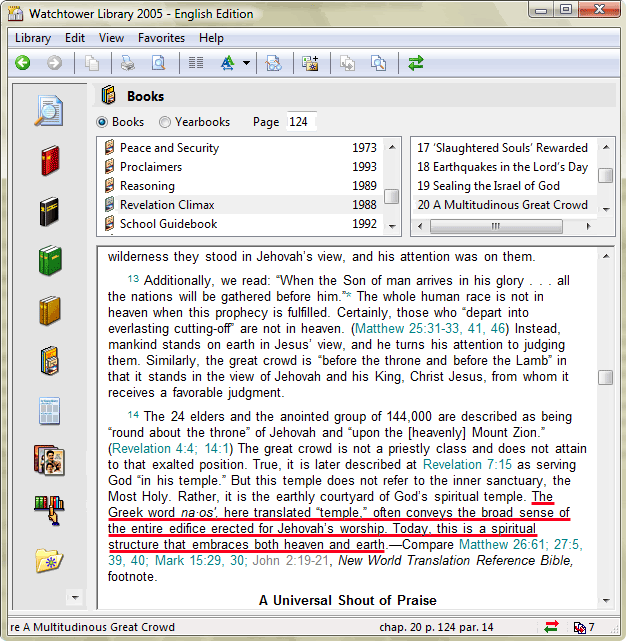In Revelation 7:15, the NWT says that a great crowd who had just come out of the great tribulation would be rendering sacred service to God "day and night in his temple."
In the book, Revelation—Its Grand Climax At Hand!, the explanation of this verse is given as follows:
This temple does not refer to the inner sanctuary, the Most Holy. Rather, it is the earthly courtyard of God’s spiritual temple. The Greek word naos, here translated “temple,” often conveys the broad sense of the entire edifice erected for Jehovah’s worship. Today, this is a spiritual structure that embraces both heaven and earth.
Here is the text as it appears in context in the 2005 Watchtower Library CD-ROM English:
I thought it would be helpful to show all the instances of naos in Revelation so that a fair determination could be made about how this word is used in Revelation.
Revelation 3:12 “‘The one that conquers—I will make him a pillar in the temple of my God, and he will by no means go out [from it] anymore, and I will write upon him the name of my God and the name of the city of my God, the new Jerusalem which descends out of heaven from my God, and that new name of mine.
Revelation 7:15 That is why they are before the throne of God; and they are rendering him sacred service day and night in his temple; and the One seated on the throne will spread his tent over them.
Revelation 11:1-2 And a reed like a rod was given me as he said:“Get up and measure the temple [sanctuary] of God and the altar and those worshiping in it. But as for the courtyard that is outside the temple [sanctuary], cast it clear out and do not measure it, because it has been given to the nations, and they will trample the holy city underfoot for forty-two months.
Revelation 11:19 And the temple [sanctuary] of God that is in heaven was opened, and the ark of his covenant was seen in his temple [sanctuary]. And there occurred lightnings and voices and thunders and an earthquake and a great hail.
Revelation 14:15-17 And another angel emerged from the temple [sanctuary], crying with a loud voice to the one seated on the cloud:“Put your sickle in and reap, because the hour has come to reap, for the harvest of the earth is thoroughly ripe.” And the one seated on the cloud thrust in his sickle on the earth, and the earth was reaped. And still another angel emerged from the temple [sanctuary] that is in heaven, he, too, having a sharp sickle.
Revelation 15:5-6 And after these things I saw, and the sanctuary of the tent of the witness was opened in heaven, and the seven angels with the seven plagues emerged from the sanctuary, clothed with clean, bright linen and girded about their breasts with golden girdles.
Revelation 15:8 And the sanctuary became filled with smoke because of the glory of God and because of his power, and no one was able to enter into the sanctuary until the seven plagues of the seven angels were finished.
Revelation 16:1 And I heard a loud voice out of the sanctuary say to the seven angels:“Go and pour out the seven bowls of the anger of God into the earth.”
Revelation 16:17 And the seventh one poured out his bowl upon the air. At this a loud voice issued out of the sanctuary from the throne, saying:“It has come to pass!”
Revelation 21:22 And I did not see a temple in it, for Jehovah God the Almighty is its temple, also the Lamb [is].
Is it even possible, given the use of "aule" for courtyard at Revelation 11:1, 2, for anyone to imagine the courtyard would contain valuable and faithful worshippers of God? The text of Revelation 11:1, 2 plainly situates the courtyard as outside the naos or 'temple'. Why does the Governing Body explanation of Revelation 7:15 place the courtyard inside the naos?
It is clear that the Bible teaches the "great crowd" will be rendering sacred servce day and night in the heavenly temple. When Jehovah's Witnesses teach that the great crowd of Revelation 7:9-17 will be located on earth, they are teaching a myth.
